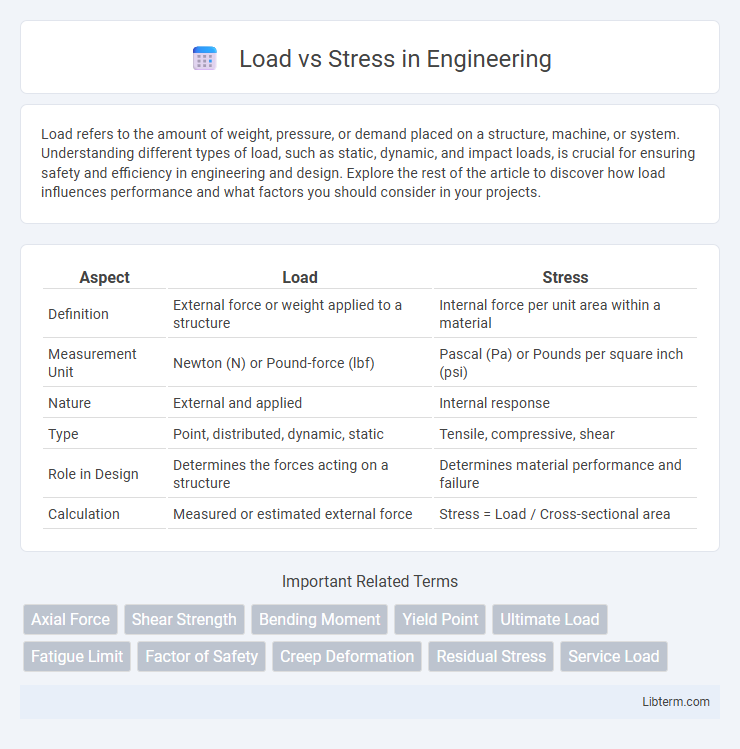Load refers to the amount of weight, pressure, or demand placed on a structure, machine, or system. Understanding different types of load, such as static, dynamic, and impact loads, is crucial for ensuring safety and efficiency in engineering and design. Explore the rest of the article to discover how load influences performance and what factors you should consider in your projects.
Table of Comparison
| Aspect | Load | Stress |
|---|---|---|
| Definition | External force or weight applied to a structure | Internal force per unit area within a material |
| Measurement Unit | Newton (N) or Pound-force (lbf) | Pascal (Pa) or Pounds per square inch (psi) |
| Nature | External and applied | Internal response |
| Type | Point, distributed, dynamic, static | Tensile, compressive, shear |
| Role in Design | Determines the forces acting on a structure | Determines material performance and failure |
| Calculation | Measured or estimated external force | Stress = Load / Cross-sectional area |
Understanding Load and Stress: Key Concepts
Load refers to the external forces or moments applied to a structure or material, inducing internal responses. Stress represents the internal resistance developed per unit area within the material, resulting from the applied load. Understanding the relationship between load and stress is crucial for assessing structural integrity and ensuring safety in engineering design.
Types of Load in Engineering and Physics
Types of load in engineering and physics include static, dynamic, axial, shear, torsional, and bending loads, each influencing structures differently based on force application and direction. Static loads remain constant or change slowly over time, while dynamic loads vary rapidly and can induce vibrations or shocks. Understanding these load types is crucial for designing safe, efficient structures capable of withstanding various mechanical stresses.
Defining Stress: The Response to Load
Stress is the internal force per unit area that develops within a material in response to an applied load, reflecting how the material resists deformation. It quantifies the intensity of internal forces acting on specific cross-sectional areas, measured in units like pascals (Pa) or megapascals (MPa). Understanding stress is critical for predicting material behavior under different types of loads such as tensile, compressive, or shear forces.
Relationship Between Load and Stress
Load directly influences stress by creating internal forces within a material or structure; as the applied load increases, the stress experienced by the material also rises proportionally. Stress, defined as force per unit area (measured in Pascals or psi), quantifies the intensity of internal forces resisting deformation caused by external loads. Understanding the precise relationship between load and stress is critical for engineering design to ensure structural integrity and prevent failure under various load conditions.
Factors Influencing Load and Stress
Load and stress are influenced by factors such as material properties, geometric dimensions, and external forces applied to a structure. Environmental conditions like temperature, humidity, and corrosion can also significantly affect the magnitude and distribution of stress within a material. Structural design, including support conditions and load application points, plays a crucial role in determining how load translates into stress.
Stress-Strain Curve: Interpreting Material Behavior
Stress-strain curves illustrate the relationship between the applied load and the resulting deformation, providing critical insight into material behavior under stress. The curve's initial linear region represents elastic deformation where stress is proportional to strain, followed by a yield point indicating the onset of plastic deformation. Analyzing key points such as the elastic limit, yield strength, ultimate tensile strength, and fracture point on the curve helps engineers predict material performance and failure modes.
Calculating Load and Stress: Essential Formulas
Calculating load involves determining the external force acting on a structure, typically measured in Newtons (N) or pounds (lbs), while stress measures the internal resistance generated within materials under load, expressed in Pascals (Pa) or psi. Essential formulas include load calculation as \( F = m \times a \) (force equals mass times acceleration) and stress calculation as \( \sigma = \frac{F}{A} \), where \( \sigma \) is stress, \( F \) is the applied load, and \( A \) is the cross-sectional area. Accurate application of these formulas ensures structural integrity by quantifying how materials withstand forces.
Real-World Examples: Load vs Stress Applications
In structural engineering, load refers to external forces like weights or impacts applied to a structure, while stress measures the internal resistance generated within the material due to these forces. For example, bridges experience dynamic loads from traffic, causing stress that designers analyze to prevent material failure. Similarly, aircraft wings endure aerodynamic loads that induce stress, requiring careful material selection to maintain safety and performance.
Common Mistakes in Distinguishing Load and Stress
Common mistakes in distinguishing load and stress often involve confusing load as the force applied and stress as the material's response. Load refers to the external force acting on a structure, while stress quantifies the internal resistance per unit area within the material. Misinterpreting these concepts can lead to inaccurate structural analysis and potential design failures.
Optimizing Design: Managing Load and Stress Efficiently
Optimizing design requires accurately calculating both load and stress to ensure structural integrity and safety. Engineers use advanced simulation tools to predict how different loads, such as static, dynamic, or environmental forces, affect material stress and deformation. Efficient load and stress management enhances durability, reduces material costs, and improves overall performance in civil, mechanical, and aerospace engineering projects.
Load Infographic

 libterm.com
libterm.com